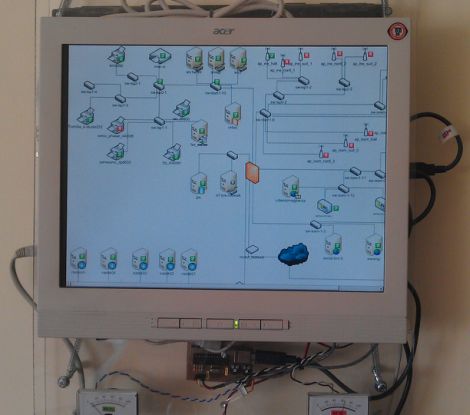
One of the benefits of working in IT is that there is typically a healthy supply of miscellaneous, half-functioning equipment to mess around with. [Vittore] had an old laptop with a busted LCD sitting around (Google Translation), so he figured he might as well get it to do something useful. With a spare desktop LCD panel and some software tweaking, he built himself a slick network monitoring panel that hangs in his office.
He stripped the laptop down to the bare essentials, and mounted it along with an LCD screen in a plexiglass enclosure. He has Nagios running a server in his office, and with the help of a few plugins, he created a simple web interface that show him the topology of his entire network. The panel itself runs a live version of Debian, which he configured to load up his Nagios web page each time it is started.
While having the ability to view the status of every network-connected device in an instant is great, he didn’t stop there. While browsing around online, he found diagram for a simple USB-based performance monitor that uses a PIC to drive a pair of VU meters. He hooked the meters up to a router monitored by Nagios, so he can watch office’s bandwidth usage in real time.
If you’re interested in seeing how it was built, be sure to check out the Flickr photo set put together by [Vittore’s] co-worker [Matthew].














Now that is a cool way to resurrect equipment that is otherwise un-useable…
I dunno… I mean, I work in IT and the problem I always have with ideas like this is that there’s just so much broken hardware lying around, but not nearly enough *useful* old hardware.
Also, he totally should have stripped that ugly beige bezel off the LCD before mounting on the plexi… :)
I should clarify – to me, “useful” means that there are at least 2 or 3 backup parts in the bin for each part used in the junk build. Without that, the natural death of aging hardware could invalidate all of the work up until that point. 3-4 total identical retired laptops, with or without broken screens, are hard to come by
This will vary from environment to environment. If you are working with smaller offices that tend to buy equipment 1 piece at a time, yes, it’s hard to come by. If you are in a larger environment, where there are workstations in use in the hundereds, then it’s much easier, as equipment will typically be purchased in bulk, thus resulting in multiple pieces of the same or substantially similar equipment for this type of project. For this project, the system board, cd/dvd drive, and monitor are near universal parts, and the replacement doesn’t need to be of the same model. If the laptop system board breaks, an old desktop could be swapped out to perform the same function, or another laptop system board. Only thing that might not survive such a swap would be the enclosure.
The graphics remind me of the “hacking” in Deus Ex: Human Revolution.
i want one so badly
Except for short term use during an emergency, An IT department isn’t going to use junk for the daily operations of a business, if they value their jobs. For that reason I have to assume that this is a duplication of tools already in use, and that this build, is to serve the builder in some non-critical manner. I like the use of the the old meters. Does the cloud on the display represent a connection to the “cloud”, and if so does the stormy appearance of it mean some problem?
HAHAAH – JUNK DOMINATES! Still got win 95 computers running laser pip mark machines turning out 200k a month in parts.
As a facilities manager for a school that runs hundreds of machines at various offices I can attest that you rarely get the tools you need from owners/managers unless the business will absolutely not function without them. Even cheap things will not be purchased unless there’s no other choice.
That being said you would have to be an idiot of an IT professional to have only one point of failure in anything, especially network infrastructure. It looks to me that the one with the ingenuity to set this up would not be so dense. Long story short: IT professionals arent always in charge of the tools they get to do their jobs, accountants are. So reusing junk is the bread and butter of IT at many businesses.
The only bad thing is that its based on a product that is quite expensive…
what product is that? Nagios is free software, so is Debian. Do you mean hardware? This could run on almost anything. Maybe the uc?